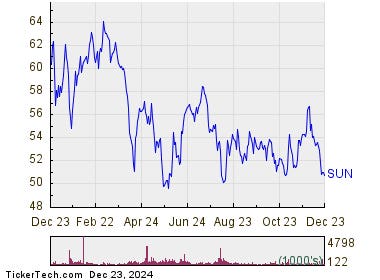Legendary investor Warren Buffett famously advocates for a contrarian approach to investing, advising individuals to be fearful when others exhibit greed, and conversely, to embrace greed when widespread fears grip the market. This principle can guide investors in identifying potential opportunities, particularly in navigating volatility when stock prices are influenced by market sentiment rather than fundamental value. One effective method to gauge the sentiment surrounding a stock is through the use of the Relative Strength Index (RSI), a technical analysis tool that measures the momentum of a stock’s price movement on a scale from 0 to 100. Typically, an RSI reading below 30 indicates that a stock may be oversold, suggesting a potential buying opportunity as investors might be overly pessimistic.
In recent trading activity, shares of Sunoco (ticker symbol: SUN) have entered deeply oversold territory, registering an RSI of 29.9. This figure signals that the stock has been under significant selling pressure, driving its prices down to $49.62 per share. For context, the S&P 500 ETF (SPY), a broader market indicator, currently reveals a higher RSI of 43.6. This contrast could imply that while the general market sentiment remains relatively neutral, Sunoco may be a candidate for a rebound. For bullish investors, such a low RSI reading suggests that the most intense selling may be tapering off, presenting a ripe opportunity to consider entering a position before any potential price recovery.
The historical performance of Sunoco’s shares further contextualizes its current standing. Over the past year, the stock has fluctuated within a 52-week range, hitting a low of $49.45 and a peak of $64.89. The recent trading session concluded with a share price of $50.22, highlighting that it is nearing its low for the year. This sharp decline suggests that external factors have contributed to the negative sentiment surrounding the company, which may be disconnected from its underlying financial health. Investors often look for such discrepancies to capitalize on mispriced opportunities in the market.
In examining market strategies, understanding how fear and greed manifest can significantly influence investment decisions. When a stock’s RSI drops below the critical 30-mark, it can indicate that panic selling has occurred, often driven by macroeconomic news or sector-specific challenges. Here, traders and investors can leverage the RSI as an indicator to either buy into stocks with potential for reversal or add to existing positions reflecting underlying value. It is not only essential to observe the RSI, but also to watch for confirming indicators or trends in trading volume that may signal a reversal in price momentum.
Transitioning from the RSI approach to broader market implications, investors should remain cognizant of external factors that generate fear or greed, such as economic reports, corporate earnings releases, or geopolitical events. Each of these elements can significantly sway investor perception and market dynamics, creating opportunities that align with Buffett’s investment philosophy. As markets navigate uncertainty, identifying fear-driven oversold conditions can serve as a pivotal strategy for astute investors aiming to capitalize on potential upturns when the market sentiment eventually shifts towards optimism.
As a practice, investors looking to refine their skills in technical analysis should consider familiarizing themselves with key indicators like the RSI to build a robust framework for decision-making. They may also benefit from studying historical price movements and sector performances to gain insights into market behavior. When employed judiciously, these techniques can enhance the ability to navigate market fluctuations, ultimately leading to more informed investment choices that echo the timeless wisdom of investing against the crowd.

